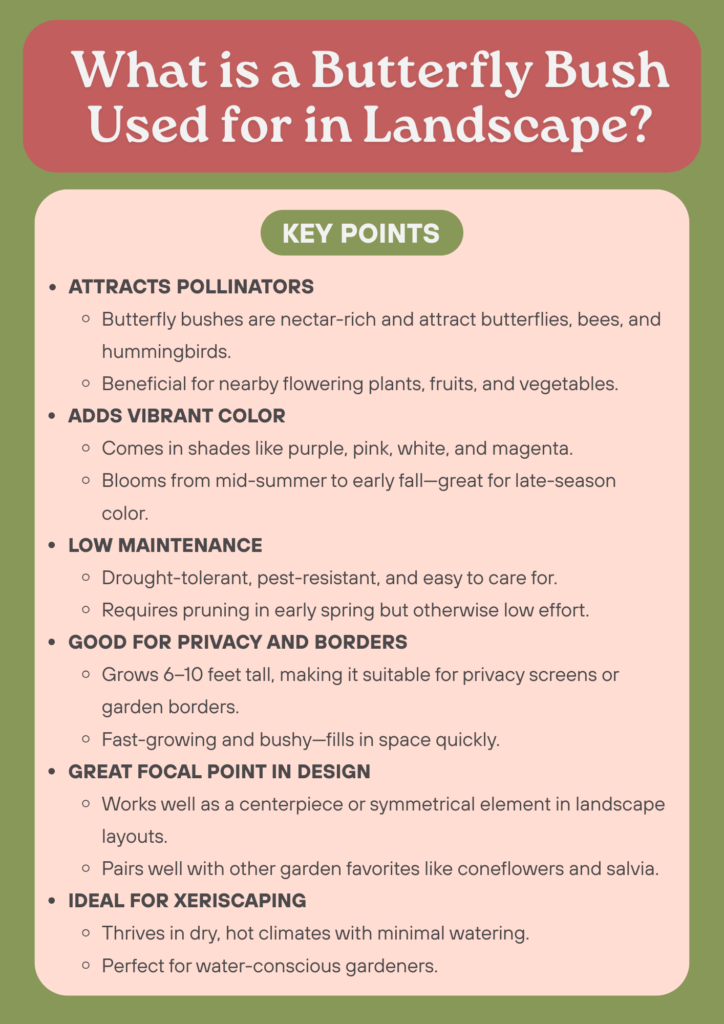Okay, so let’s talk about something kinda underrated in the world of gardening and landscaping the butterfly bush. You’ve probably heard the name before (or maybe not, no judgment here!), but if you’re wondering what is a butterfly bush used for in landscape, you’re in the right place.
This plant is like the multitasker of the garden world. It looks pretty, smells amazing, and it brings all the butterflies to the yard (literally). Whether you’re a total plant nerd or just someone trying to make their yard less “blah,” the butterfly bush might just be your new BFF. Let’s dig into what makes this beauty so dang useful when it comes to landscaping.
Table of Contents

1. It Attracts Pollinators Like Crazy
First and foremost, the name isn’t lying—butterfly bushes are magnets for butterflies. And not just butterflies, but also bees, hummingbirds, and other friendly little pollinators. Why does this matter? Well, if you’re growing any kind of flowering plants or even fruits and veggies nearby, having pollinators around is a huge win.
The butterfly bush (Buddleja davidii, if you wanna get fancy with it) blooms in big clusters of vibrant, cone-shaped flowers that are just packed with nectar. Butterflies can’t resist ‘em, and let’s be real—you probably won’t be able to resist watching them flit around your yard, either.
2. Adds a Pop of Color (and Then Some)
Another reason landscapers and homeowners love butterfly bushes is that they’re super colorful. These things come in shades of purple, pink, white, and even deep magenta. And the flowers usually bloom from mid-summer all the way into early fall—so just when other flowers are starting to slow down, the butterfly bush keeps the show going.
If you’ve got a dull or empty corner in your garden that needs a bit of “wow,” a butterfly bush might just be the fix.
3. Low Maintenance (Like, Seriously)
Let’s be honest. Not everyone has the time (or the patience) to baby their plants. One of the best parts about butterfly bushes is that they’re low-maintenance as heck. They don’t need a lot of water once they’re established, they’re drought-tolerant, and they’re generally pest-resistant too. Like, what more could you want?
You do need to prune them back in early spring to keep them from getting leggy, but that’s about it. Even people with a not-so-green thumb can usually keep these babies thriving.
4. Great for Privacy and Borders
Butterfly bushes can grow pretty tall—up to 6 to 10 feet, depending on the variety. That makes them a solid option if you’re trying to create a bit of privacy or section off part of your yard.
They work really well as natural borders along fences, patios, or driveways. And because they grow fast, you won’t have to wait forever for them to fill in. Just make sure you give ‘em enough space because they can get kinda bushy (no surprise there, right?).
5. Perfect Focal Point for Garden Design
If you’re into garden design—or even just pretending you are—butterfly bushes can totally be a focal point in your landscape layout. Plop one in the center of a flower bed, or use a few to create symmetry in your front yard. They stand out without being too flashy, and they pair well with a ton of other plants like coneflowers, black-eyed Susans, and salvia.
Plus, the movement and color from all the butterflies fluttering around? Chef’s kiss. It’s like free animation in your garden.
6. Useful in Xeriscaping (a.k.a. Drought-Friendly Landscaping)
Live somewhere dry? No worries. Butterfly bushes are excellent for xeriscaping, which is just a fancy term for landscaping with drought-tolerant plants. Once they’re established, they need very little water and can handle hot, dry conditions like champs.
So if you’re trying to reduce your water bill—or you just forget to water stuff (we’ve all been there)—a butterfly bush is a solid pick.
7. They Can Be Invasive (So a Tiny Heads-Up)
Alright, let’s keep it real for a sec. While butterfly bushes are amazing, some varieties can be invasive—especially in certain parts of the U.S. They can spread by seed and crowd out native plants if you’re not careful.
BUT—don’t panic—there are sterile or non-invasive cultivars out there that won’t cause any trouble. Look for varieties like ‘Miss Molly’ or ‘Lo & Behold’ that are designed to be garden-friendly and won’t spread like crazy.
Final Thoughts:
If you’re still asking yourself “what is a butterfly bush used for in landscape?”—well, the answer is: a lot of things. It’s beautiful, functional, easy to care for, and an absolute hit with pollinators. Whether you want to bring some life into a dull yard, attract butterflies, or just try out a new plant that won’t give you a headache, the butterfly bush checks a whole bunch of boxes.
Just make sure you check whether your area allows them (due to the invasive factor), and opt for the newer, non-invasive types if needed. Otherwise, go wild and enjoy the color, movement, and good vibes that come with it.

